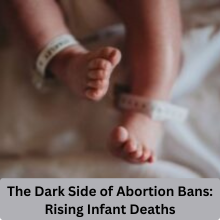
Understanding the Context of Roe v. Wade
Significance of Roe v. Wade
Roe v. Wade was a crucial 1973 Supreme Court ruling that confirmed a woman’s right to choose an abortion. It was based on the right to privacy and greatly influenced reproductive rights in the U.S., shaping women’s access to pregnancy-related healthcare.
Changes After the Overturning
In June 2022, the Supreme Court overturned Roe v Wade allowed states to make their own abortion laws. This resulted in numerous near-total abortion bans in many states, limiting access to safe and legal abortion services for many women.
Research Study Overview
Study Conducted by Ohio State University
A recent study in JAMA Pediatrics assessed the impact of abortion bans on infant mortality rates. Researchers aimed to evaluate the effects of these restrictions after the Roe overturn.
Key Findings
The study found a disturbing rise in infant deaths after Roe was overturned. Overall infant mortality increased by about 7% in specific months. For instance, in October 2022, March 2023, and April 2023, there were about 247 more infant deaths per month than expected.
Alarming Statistics
Rising Infant Mortality Rates
The findings show that infant mortality rates consistently exceeded expected levels over the 18 months following the Dobbs decision. This indicates a serious issue tied to restricted access to abortion and healthcare.
Monthly Breakdown of Deaths
In October 2022 alone, infant death rates were significantly higher than historical averages.
Impact on Congenital Anomalies
A notable contributor to increased deaths was congenital anomalies. The research indicated a 10% rise in infant mortality from these conditions in six out of the 18 months studied. Many of these anomalies are diagnosed during pregnancy, allowing parents to make informed choices that are now limited in many states.
Reasons for Increased Infant Deaths
Role of Abortion Bans
Abortion bans have serious implications. Many parents need the option to terminate pregnancies with severe fetal anomalies. Without this choice, families may have to carry to term pregnancies that result in infants unable to survive.
Access to Prenatal Care
These bans also impact access to essential prenatal care. Women denied abortions face greater risks during pregnancy due to inadequate medical support. Fewer options lead to worse health outcomes for mothers and infants.
Socioeconomic Factors
Socioeconomic status significantly affects health outcomes. Women from low-income backgrounds encounter more barriers to accessing healthcare, including abortion services. These barriers worsen health risks for both mothers and infants.
Comparative Analysis
Case Studies from Texas
Texas has seen a marked increase in infant mortality following its six-week abortion ban. Research shows that infant deaths in the first year of life rose by 13% after this law took effect, illustrating the broader implications of state-level abortion restrictions.
National Ripple Effect
The Ohio State study suggests a national ripple effect, where state abortion policies impact health outcomes across the country. This highlights the importance of viewing reproductive health as a national issue.
Also read: Urgent: Duloxetine Bottles Recalled Due to Toxic Risk!
MExpert Insights
Researcher Perspectives
Experts like Dr. Parvati Singh stress that rising infant mortality rates indicate broader health challenges due to reduced access to abortion services. This emphasizes the need to treat reproductive rights as a public health priority.
Public Health Implications
These findings suggest a potential public health crisis, where limited access to reproductive care leads to widespread negative outcomes for families and communities.
Broader Implications of Abortion Restrictions
Effects on Maternal Health
Abortion restrictions also pose risks to maternal health. Women denied medically necessary abortions face higher health risks and complications during pregnancy.
Cycle of Poor Health Outcomes
Maternal and infant health are closely linked. Lack of access to comprehensive healthcare leads to adverse outcomes that can affect future generations.
Conclusion: Need for Comprehensive Healthcare
Addressing the Crisis
In light of the Dobbs decision, discussions must focus on a holistic approach to healthcare. This includes advocating for reproductive rights and ensuring all pregnant individuals have access to necessary care for healthy pregnancies.
Policy Recommendations
Policymakers should create inclusive healthcare systems that meet the needs of all individuals. This involves removing barriers to essential services, including abortion and prenatal care.
Also read: Tom Holland’s Surprising Role in Nolan’s Next Blockbuster
FAQs
Current Status of Infant Mortality Rates
Infant mortality rates have increased in certain months after the Roe v. Wade overturn, with studies showing hundreds more infants died than expected.
Impact of Abortion Bans on Infant Health
Abortion bans limit access to vital healthcare services, increasing risks for both infants and mothers, especially in cases of severe fetal anomalies.
Studies Linking Abortion Restrictions to Maternal Health
Research shows that abortion restrictions lead to negative health outcomes for mothers, including a higher risk of complications during pregnancy.
Role of Socioeconomic Factors in Infant Mortality
Socioeconomic status plays a significant role in healthcare access, including abortion services, which impacts health outcomes for mothers and infants.
Improving Maternal and Infant Health
Enhancing health outcomes requires a focus on comprehensive healthcare access, including reproductive rights, prenatal care, and support for low-income families.

